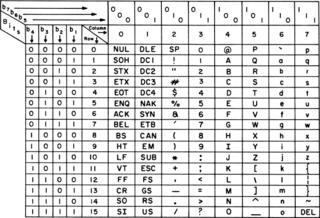
ASCII, abbreviated from American Standard Code for Information Interchange, is a character encoding standard for electronic communication. ASCII codes represent text in computers, telecommunications equipment, and other devices. Because of technical limitations of computer systems at the time it was invented, ASCII has just 128 code points, of which only 95 are printable characters, which severely limited its scope. Modern computer systems have evolved to use Unicode, which has millions of code points, but the first 128 of these are the same as the ASCII set.
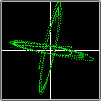
Radioteletype (RTTY) is a telecommunications system consisting originally of two or more electromechanical teleprinters in different locations connected by radio rather than a wired link. Radioteletype evolved from earlier landline teleprinter operations that began in the mid-1800s. The US Navy Department successfully tested printing telegraphy between an airplane and ground radio station in 1922. Later that year, the Radio Corporation of America successfully tested printing telegraphy via their Chatham, Massachusetts, radio station to the R.M.S. Majestic. Commercial RTTY systems were in active service between San Francisco and Honolulu as early as April 1932 and between San Francisco and New York City by 1934. The US military used radioteletype in the 1930s and expanded this usage during World War II. From the 1980s, teleprinters were replaced by personal computers (PCs) running software to emulate teleprinters.

A teleprinter is an electromechanical device that can be used to send and receive typed messages through various communications channels, in both point-to-point and point-to-multipoint configurations. Initially they were used in telegraphy, which developed in the late 1830s and 1840s as the first use of electrical engineering, though teleprinters were not used for telegraphy until 1887 at the earliest. The machines were adapted to provide a user interface to early mainframe computers and minicomputers, sending typed data to the computer and printing the response. Some models could also be used to create punched tape for data storage and to read back such tape for local printing or transmission.
Asynchronous serial communication is a form of serial communication in which the communicating endpoints' interfaces are not continuously synchronized by a common clock signal. Instead of a common synchronization signal, the data stream contains synchronization information in form of start and stop signals, before and after each unit of transmission, respectively. The start signal prepares the receiver for arrival of data and the stop signal resets its state to enable triggering of a new sequence.
Electronic business is any kind of business or commercial transaction that includes sharing information across the internet. Commerce constitutes the exchange of products and services between businesses, groups, and individuals and can be seen as one of the essential activities of any business.

NEC Corporation is a Japanese multinational information technology and electronics corporation, headquartered at the NEC Supertower in Minato, Tokyo, Japan. It provides IT and network solutions, including cloud computing, artificial intelligence (AI), Internet of Things (IoT) platform, and telecommunications equipment and software to business enterprises, communications services providers and to government agencies, and has also been the biggest PC vendor in Japan since the 1980s when it launched the PC-8000 series.

The Teletype Model 33 is an electromechanical teleprinter designed for light-duty office use. It is less rugged and cost less than earlier Teletype models. The Teletype Corporation introduced the Model 33 as a commercial product in 1963, after it had originally been designed for the United States Navy. The Model 33 was produced in three versions:
An e-commerce payment system facilitates the acceptance of electronic payment for offline transfer, also known as a subcomponent of electronic data interchange (EDI), e-commerce payment systems have become increasingly popular due to the widespread use of the internet-based shopping and banking.

Hanson UK is the former name of Heidelberg Materials. Originally known as Hanson Trust plc, it is a British-based building materials company, headquartered in Maidenhead. The company has been a subsidiary of the German company HeidelbergCement since August 2007, and was formerly listed on the London Stock Exchange and a constituent of the FTSE 100 Index.
Smith Corona is an American manufacturer of thermal labels, direct thermal labels, and thermal ribbons used in warehouses for primarily barcode labels. Once a large U.S. typewriter and mechanical calculator manufacturer, it expanded aggressively during the 1960s to become a broad-based industrial conglomerate whose products extended to paints, foods, and paper. The mechanical calculator sector was wiped out in the early 1970s by the production of cheap electronic calculators, and the typewriter business collapsed in the mid-1980s due to the introduction of PC-based word processing.
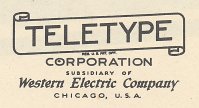
The Teletype Corporation, a part of American Telephone and Telegraph Company's Western Electric manufacturing arm since 1930, came into being in 1928 when the Morkrum-Kleinschmidt Company changed its name to the name of its trademark equipment. Teletype was responsible for the research, development and manufacture of data and record communications equipment, but it is primarily remembered for the manufacture of electromechanical teleprinters.
Epicor Software Corporation is a business software company based in Austin, Texas founded in 1972. Its products are aimed at the manufacturing, distribution, retail and services industries.
Sumitomo Electric Industries, Ltd. is a manufacturer of electric wire and optical fiber cables. Its headquarters are in Chūō-ku, Osaka, Japan. The company's shares are listed in the first section of the Tokyo, Nagoya Stock Exchanges, and the Fukuoka Stock Exchange. In the period ending March 2021, the company reported consolidated sales of US$26,5 billion.
Edward Ernst Kleinschmidt was a German-American engineer. He was one of the inventors of the teleprinter, and obtained 118 patents over the course of his lifetime.

Joy Sterling Morton was an American businessman and entrepreneur best known for founding Morton Salt and establishing the Morton Arboretum in Lisle, Illinois.
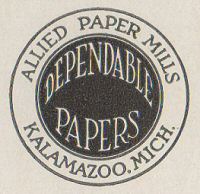
The Allied Paper Corporation was created in 1921 by a merger of three paper mills in Kalamazoo and Otsego, both in South-West Michigan, USA. The company grew steadily over the next 40 years but when local forests had been logged off and when profits could no longer support further investments and updates it became uncompetitive. Allied mills were closed or sold during the 1970s and 1980s, and the corporation passed into history during 1988. Hundreds of millions of dollars have since been spent in South West Michigan cleaning up the last Allied Paper mill site and the PCB pollution caused by this company.
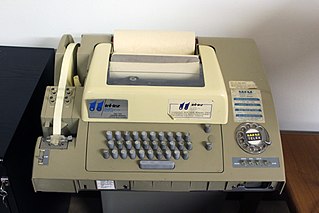
Telex is a telecommunication service that provides text-based message exchange over the circuits of the public switched telephone network or by private lines. The technology operates on switched station-to-station basis with teleprinter devices at the receiving and sending locations. Telex was a major method of sending written messages electronically between businesses in the post–World War II period. Its usage went into decline as the fax machine grew in popularity in the 1980s.
Kleinschmidt is an occupational surname of German origin, which means "small smith", that is, a maker of small forged items and metal hand tools. The name may refer to:

The Kleinschmidt keyboard perforator is a telegraph instrument invented by Edward Kleinschmidt which prepares punched tape for telegraph transmission. A QWERTY keyboard operate hole punches that prepare a Wheatstone slip. Each Morse code of the dots and dashes for the letter is selected by projecting tongues on the key bar. The centre holes used for the paper feed are punched first, then the lower holes, and then the upper holes. The upper holes are the mark holes, which indicate when the symbol starts, and the lower hole tell when to terminate the symbol. This keyboard can be operated at up to 80 words a minute by a skilled operator.










